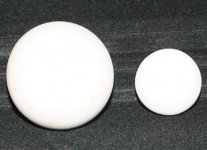Some farmers in China are trying to use similar methods used in SSP.
I have asked one bead manufacture why he does not use the shells of saltwater oysters. They told me that those beads are not densely enough and easily to be broken up.
Josh, Is the shell of saltwater oysters not solid?
I have asked one bead manufacture why he does not use the shells of saltwater oysters. They told me that those beads are not densely enough and easily to be broken up.
Josh, Is the shell of saltwater oysters not solid?

